
Sunday December 28, 2003
Scalextric
Ford Falcon & Holden Commodore
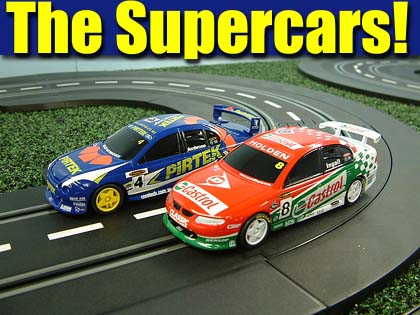 What
was it about these 2 models that made me tell myself I had to have them?
NOW available here in the U.S., I looked at these releases as ones
that just might employ one of my favorite aspects of the hobby: Simplicity.
Arriving here safe and sound from our friends at Millennium Raceway, it was
finally time to get a closer look, and the more we looked the more we liked!
What
was it about these 2 models that made me tell myself I had to have them?
NOW available here in the U.S., I looked at these releases as ones
that just might employ one of my favorite aspects of the hobby: Simplicity.
Arriving here safe and sound from our friends at Millennium Raceway, it was
finally time to get a closer look, and the more we looked the more we liked!
Of course the first thing one will notice is the lack of any visible interior, but to be honest it doesn't bother me as much as I thought it would. The main reason is that these models are after all still Scalextric, and they come with their usual high standard of Tampo-markings and clear-coat. The body moldings were are clean and chassis to body fit is about as smooth as you could ask for. With a price tag of only $29.95, these cars are a great value for the enthusiast regardless of being void of any interior detail.
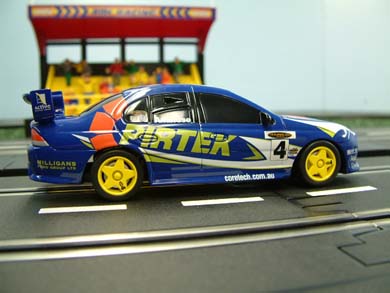
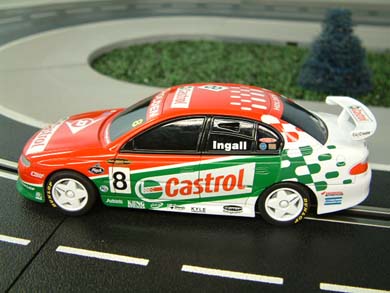
Based on the V8 Supercars ran in Australia, both of these models matched the prototype photos quite nicely. I was privileged to receive some motor sport magazines from our friends at Millennium Raceway that extensively covers this popular series, and some great photos of the prototypes were enough to tell me Scalextric did a fine job in capturing these beauties in scale. Of course as with virtually all models there are a few discrepancies here and there with certain markings but for the most part they capture the prototype nicely in my eyes. The models do seem to sit slightly higher than the prototype but I still thought Scalextric got them very close. This of course could just be my eyes playing tricks on me, and I will let those more familiar with the series to give us a better judgment over time.
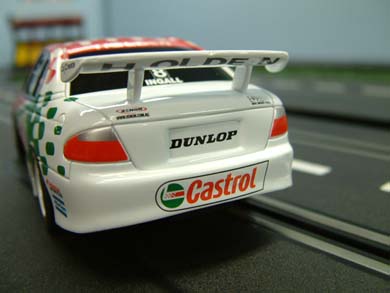
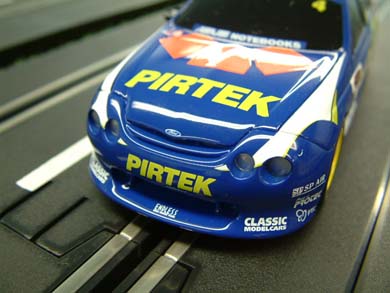
Now what about those of us who like full interiors? Well again, I have to say that for some reason it didn't take away from these models as much as I thought. A full or half tray interior would certainly add to the fine scale appeal of these models, and perhaps we shall see these models with them at a later date. The bodies and overall shape combined with the nice paint work and decent performance makes them "good enough" for our racing taste.
Wheels and tires here are better than you might think, although the compound of the tires seem a little harder than found on recent Scalextric releases. New compound Indy Grips would be a great upgrade, and although I found that #1005 for the VW does fit the wheel, the profile of the tire is a little too tall. Hopefully we will see some of the new compound Indy Grips available soon as the low price, these models will find their way into the hands on many enthusiasts. Until then, I found that Classic Indy Grips #PMTR4655 for the Porsche are a perfect fit. The wheels are 2 part in design with the inner rotor background glued in place inside the wheel. Thankfully, the tires and wheels were very round and true with minimal sanding required to get the best traction possible. The center lugs could be painted to match the prototype a little closer if you so desired, however I'll just leave mine the way they came.
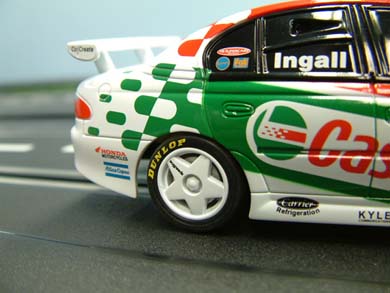
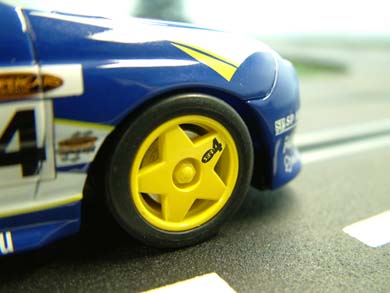
After removing the 4 screws that mount the body to the chassis, we see some familiar territory. The standard Scalextric bar magnet is here with 3 positions to choose from along with the self-centering spring loaded guide and the stock Mabuchi power-plant in the sidewinder configuration with an 11 tooth pinion driving a 36 tooth spur gear. There was some slight amount of side-to-side free-play in the rear axle so I added a 3/32 ID shim on the spur gear side between the spur gear and the bushing and this tightened things up rather well.
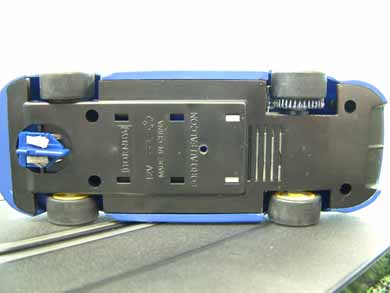
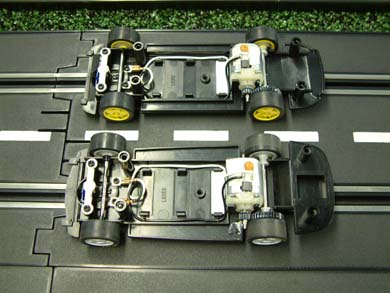
One thing I noticed is that the body mount posts are very durable and can withstand some very hard crashes (ahem). The rear axle is held in place by 2 plastic/nylon bushings and we found on both models they fit very tightly in the chassis and noticed no spinning or movement of them under load. I usually still add a drop of adhesive on top of these type of bushings as a preventive measure, but I didn't see a reason to here and will monitor them as we break them in. Although mostly self-lubricating, I still added a drop of Trinity Royal oil on each bushing as well as on each side of the motor and the solid front axle.
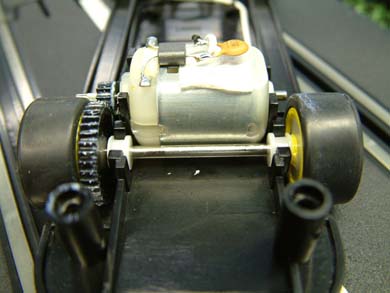
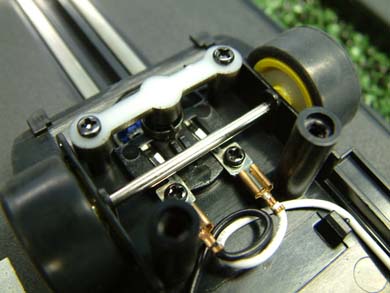
Performance of these Supercars were not a surprise given the bar magnet that Scalextric employs here, but it isn't as stuck down as I thought they would be. This is due mostly to the distance from the rails the magnet sits and some will most likely want to add some extra magnet near the front of the model. With the lack of weight due to the missing interior, the cars both seemed prone to more body roll than you may be used to, and it might take you some time to find your racing line. In its stock form with the tires sanded and trued, we posted average lap times of 3.45 seconds on our Carrera track. One thing to note...these times are for BOTH models. Having 2 different models that are this close in performance just adds to the overall appeal of them and as it stands here they are virtually identical.
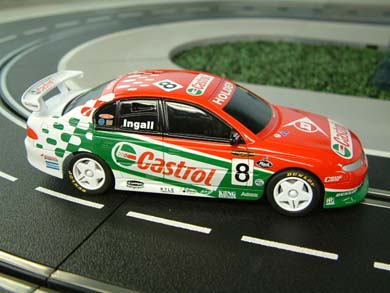
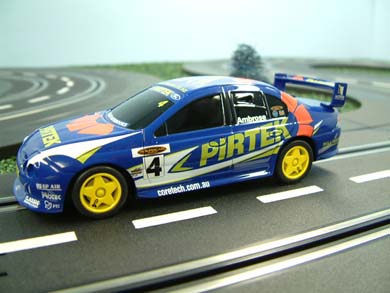
Instead of adding more magnet, I decided to add some lead weight up front to see if this helped matters...and it did. I added 1/2 ounce right between the forward and mid-position bar magnet locations and I shaved the lap times down to an average of 3.25. This isn't a lot I know, but it wasn't just the times but the handling of the model seemed much easier in the corners. As stated earlier, adding silicones will certainly help matters and I found that the wheels seemed a perfect match with the Scalextric Porsche 911 GT3R. I didn't have a spare set on hand so I used some off a Porsche to see how they fit and they worked perfectly. Lap times came down even further to an even 3.1, and we soon found ourselves enjoying this model a great deal more than we thought. Durability is fair with the side mirror being heavily molded with the body and so far the rear wings have shown to be as strong as you could ask for in this department.
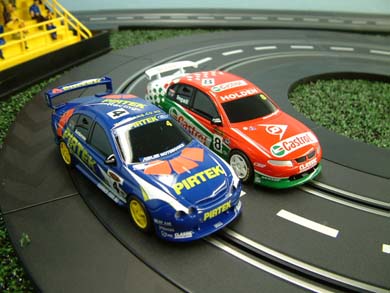 After
seeing the recent releases such as the Mercedes and
Opel, you might think I would dismiss these models based on the lack of
detail but such is not the case. For a long time my preferences have
leaned towards a model that has a balance of not only scale detail, but
performance as well. These models do fall into this category and I think they
are a great addition to your current collection. They are still fun like a slot
car should be...and as always...fun is what this hobby is all about!
After
seeing the recent releases such as the Mercedes and
Opel, you might think I would dismiss these models based on the lack of
detail but such is not the case. For a long time my preferences have
leaned towards a model that has a balance of not only scale detail, but
performance as well. These models do fall into this category and I think they
are a great addition to your current collection. They are still fun like a slot
car should be...and as always...fun is what this hobby is all about!
- Harry
This review would not be complete without an opinion from those who have waited impatiently for these models. I asked Rob Wessling of Millennium Raceway to give us a little more background on these releases and we thank them very much for not only helping us acquire these nice models, but for taking the time to add to this review.
- Rob Wessling
Thanks again Rob!